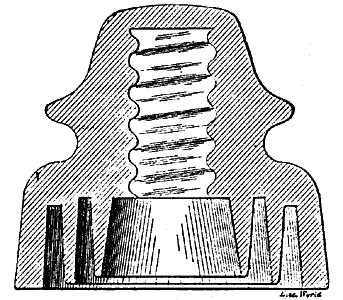[Trade Journal]
Publication: Electrical World
New York, NY, United States
vol. 21, no. 9, p. ?, col. 1
The Locke Insulator and Pin.
Insulators and insulator pins play .an important part in every installation. It is necessary that they should be cheap, simple, durable, of high insulating qualities, and easy to handle and adjust. In the manufacture of such large numbers the tendency is often toward cheapness and careless construction, but it is evident that a high grade of mechanical construction is important. Fred. M. Locke & Co., of Victor, N. Y., are the manufacturers of an insulator pin and insulator that are claimed to possess all these qualities, and to meet the severe requirements of practice in a highly satisfactory manner. Several thousand of them have already been put out and with excellent results.
 |
| The Locke Insulator. |
The insulator pin is forged from sheet steel, giving a compact and strong construction. The head of the pin, over which the glass insulator is screwed, is covered with an Insulating sleeve, which is always in, position and thoroughly protected from moisture and the effects of the weather.. The portion of the pin that passes through the cross-arm is as small as is consistent with the necessary strength, and this does not Weaken the cross-arm as wooden pins so often do. A metallic sleeve on the pin fits against the cross-arm, covering the hole and protecting it from moisture, and thus preventing decay, while at the same time it acts as a brace. This pin will stand a strain of 2,000 lbs. when set on hard pine cross-arms, whereas the oak pin will break at about 700 lbs.
The new patent triple petticoat glass insulator is shown in the accompanying illustrations. This insulator is very solid in its construction, and presents a very high insulating surface. Its use is especially recommended while leakage is an important item to be considered.
